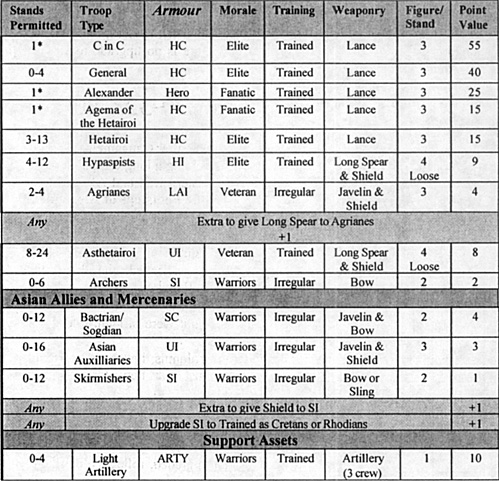Historical Themes
With the collapse of the Achaemenid government after Gaugamela, the nature of the war of conquest changed dramatically, becoming a long campaign of pursuit and the suppression of rebellion, mostly in eastern Iran and Afghanistan. The best read on this period is Michael Woods' In the Footsteps of Alexander. For our lists, significant changes were made in the Macedonian OB.
- Thessalian and Greek cavalries were sent home.
- Antigonos and most of the Greeks garrisoned the long line-of-communications from western Anatolian to Babylon.
- The prodromoi were apparently rolled into the Hetairoi
- Significant numbers of Asian horse and foot were brought into the army; the shortage of light cavalry was addressed.
- The army operated in smaller, "flying" columns, better able to react and suppress those subjects rebelling against the new Persian emperor, Alexander!
- The asthetairoi cut down their pikes for campaigning in rugged terrain, becoming in effect peltasts.
- No supply trains accompany an army on the fly.
- Macedonian morale has generally been upgraded, reflective of their long winning streak
Tactics
This army operates very effectively in delaying terrain with its good combination of cavalry, loose order foot and skirmishers. Therefore, one can really play the terrain game. On the other hand, the army is somewhat less effective in the open, and some enemies, such as good quality hoplites or Imperial Romans, will give it a run for its money. Alexander made excellent use of artillery against the Scythians, so it is obvious that flying columns or not, artillery was an important weapon in Alexander's arsenal. As noted above, players will find a battery of light artillery a handy asset to have on hand to shoot-up formations of enemy bows
Enemies: Early Hu, Indian, Later Achaemenid Persian, Later Hoplite Greek, and Scythian.
Pursuit to the East (20,000/100 stands)
B>Notes
- The pursuit to the East was conducted by flying columns of the best troops in the army, with the help of local mercenaries or allies. There is no provision for supply assets in this variation.
- Hetairoi may wedge.
- At 500 men per stand, the smaller units (Agrianes and Macedonian archers) disappear.

More Armies of Alexander the Great
-
Introduction and Technical Terms
Philip the Barbarian to 336 BC
Alexander Invades Persia 335-330 BC
Pursuit to the East 330-327 BC
India 326-323 BC
The Alexandrian Imperial Army, 323 BC
Back to Saga # 84 Table of Contents
Back to Saga List of Issues
Back to MagWeb Master Magazine List
© Copyright 2002 by Terry Gore
This article appears in MagWeb (Magazine Web) on the Internet World Wide Web. Other military history articles and gaming articles are available at http://www.magweb.com